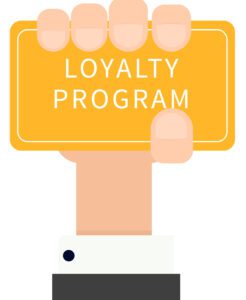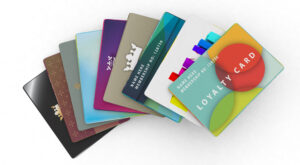
30 Invaluable Customer Loyalty Statistics

Customer loyalty programs have become a universal practice among leading retailers as a way of incentivising customers to return to their business to make more than one purchase. From coffee shops, clothing stores, airlines, and technology companies, businesses of all shapes and sizes have found a way of offering rewards to their customers and ultimately increasing their lifetime value in the meantime.

Examples of customer loyalty programs include earning “points” for every pound you spend, offering discounts to first-time customers, celebrating customer birthdays with gift cards, special rewards for referrals, and more.
These customer loyalty programs are a great way to attract new customers into their business, and it’s something that we in the PPC department at Embryo like to highlight in ad copy and ad extensions, particularly when our ads are being aimed at new customers.
If you’re interested in seeing how we can utilise PPC to highlight your business’s Customer Loyalty Programs, feel free to get in touch with our team after you’ve read this blog.
However, without further adieu, let’s begin to take a statistical look at customer loyalty programs to see what kind of impact they have on businesses and consumers by analysing their influence through the power of numbers.
(Source: Eye on Tech)
What Makes a Customer Loyal?
Understanding what makes a customer loyal is essential for designing and implementing effective customer loyalty programs. By understanding the motivations and needs of potential customers, businesses can create a program that provides them with the rewards and benefits that they value most.
- 55.3% of consumers are brand loyal because they love the product
- 37% of consumers say that it takes five or more purchases for them to consider themselves loyal to a brand.
- 39% of U.S. consumers feel loyal to brands that connect them with other providers, giving them the ability to exchange loyalty points or rewards
- 86% of loyal consumers will recommend a company to friends and family
- 75% of consumers would switch brands for a better loyalty program.
- The probability of selling to an existing customer is up to 13X greater than it is for selling to a new customer
- 13% of customers are loyalists, who don’t shop around
- Nearly 70% of consumers say their favourite brand is part of who they are
- 51% of consumers said poor product/quality might lose their loyalty and 23% said poor customer service
- 68% of millennials cited reliability and durability as having the biggest influence on loyalty
Key takings: Product quality is the key to building customer loyalty. It also takes time to build customer loyalty, but loyal customers are your biggest fans and are more likely to recommend your company to others.
Are Customer Loyalty Programs Effective?

Customer loyalty programs have become a staple of modern business, with businesses of all sizes using them to reward and retain their customers. However, there is some debate about whether customer loyalty programs are actually effective.
Some argue that customer loyalty programs are simply a waste of time and money. They point out that many customers join loyalty programs but never actually redeem their rewards. Additionally, some argue that customer loyalty programs can alienate customers who feel like they are being bombarded with marketing messages.
However, others argue that customer loyalty programs can be very effective in increasing customer spending and retention. They point to studies that have shown that customers who are members of loyalty programs tend to spend more money at the businesses that offer those programs. Additionally, they argue that customer loyalty programs can help to build stronger relationships between businesses and their customers.
- Customers who are members of loyalty programs tend to generate 12-18% more revenue growth per year than non-members.
- Loyalty programs that perform the best increase revenue from customers who use them by 15-25% each year
- Brands that understand their customers can retain their loyalty, as 56% of customers remain loyal to such brands.
- Furthermore, existing customers contribute 65% of a company’s business. Increasing customer retention by a mere 5% can lead to a 25-95% profit increase.
- Less than 8% of consumers say rewards aren’t at all important to their purchasing decisions.
- 52.3% of loyal customers will join a rewards program, and 39.4% will spend more on a product even if there are cheaper options elsewhere.
- 83% of customers are more likely to continue doing business with a brand that has a loyalty program
- 60% of loyal customers will buy more frequently
- 56% of shoppers say they changed or abandoned a purchase when they realised their points had expired
- 71% of premium loyalty members shop with brands whose programs they participate in at least once a week
- Consumers belong to an average of 14.8 loyalty programs but are active in only 6.7 programs
Key takings: Businesses with loyalty programs see more revenue from their customers, and they are more likely to retain their customers. Loyal customers also contribute more to your business, and they are also more likely to spend more money and buy from you more often.
What do Consumers Expect?
Understanding what consumers expect from customer loyalty programs is important when analysing customer loyalty programs because it helps businesses identify areas where their programs may be falling short. For example, if a business finds that many of its customers are complaining about how difficult it is to redeem their rewards, then the business may want to make it easier for customers to redeem their rewards.
Additionally, understanding what consumers expect from customer loyalty programs can help businesses identify opportunities to improve their programs. For example, if a business finds that many of its customers are interested in personalised rewards, then the business may want to focus on offering more personalised rewards to its customers.
- 40% of Millennials believe loyalty programs should offer interactive games
- 77% of consumers believe that a loyalty program should offer personalised rewards
- 72% of consumers believe a loyalty program should recognize them when they make a purchase
- When it comes to loyalty programs, 82% of consumers prefer discounts and offers, 77% free products and 66% free services
- 50% of consumers said that the primary reason they join loyalty programs is to earn rewards on everyday purchases
- 85% of Millennials believed that loyalty programs enhance their experience with a brand
- 58.7% of internet users believe earning rewards and loyalty points is a valuable part of the shopping experience
- 63% of consumers expect personalisation as a standard of service and believe they are recognised as an individual when sent special offers
Key findings: Consumers want loyalty programs that are interactive, personalised, and rewarding. They want to feel like they are valued and appreciated by the businesses they support.
Conclusion
Customer loyalty programs are a valuable tool for businesses to increase customer spending and retention, build stronger relationships with their customers, and grow their businesses.
The most important factor in building customer loyalty is product quality. It takes time to build customer loyalty, but loyal customers are your biggest fans and are more likely than non-loyal customers to recommend your company to others. Additionally, businesses with loyalty programs see more revenue from their customers and are more likely to retain their customers. Loyal customers also contribute more to your business and are more likely to spend more money and buy from you more often.
Interactive, personalised, and rewarding loyalty programs are what consumers want. They want to feel like they are valued and appreciated by the businesses they support. Overall, customer loyalty programs are an effective way to achieve these goals. If you’d like help in devising customer loyalty programs relevant to your business, then we’re here to help.
Take a look at our case studies and see how we’ve helped businesses from all different industries to improve their digital marketing performance.




